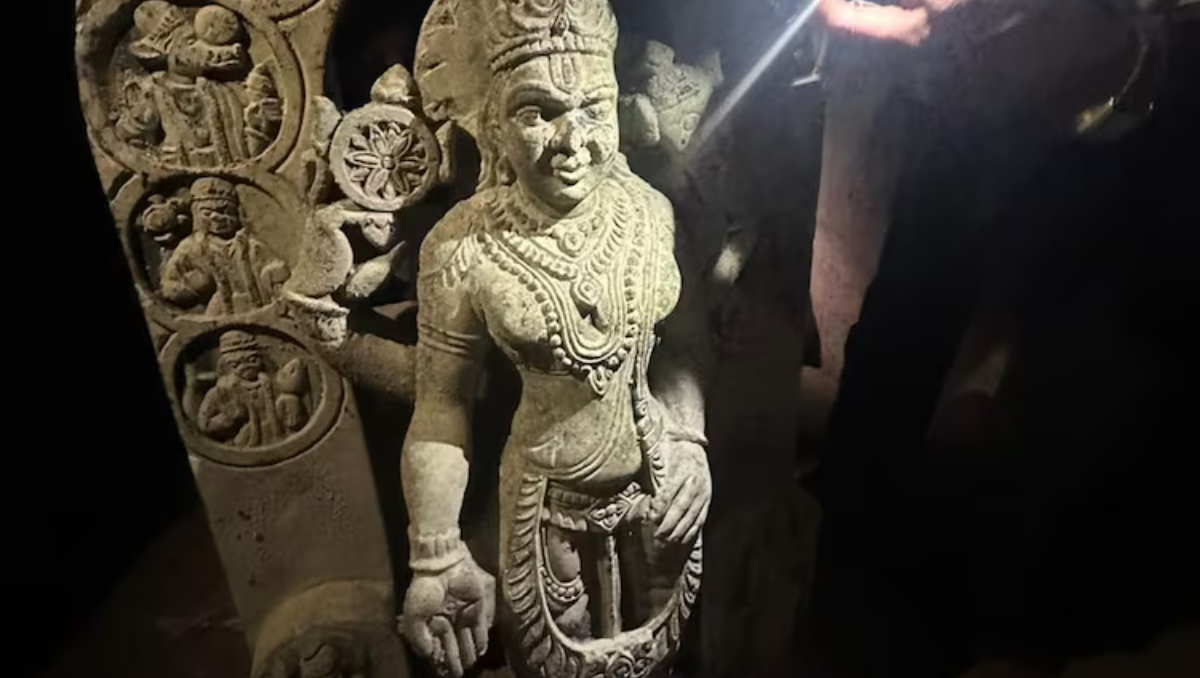An ancient statue of Lord Vishnu in its all ten incarnations, or ‘dashavatara,’was discovered near the Krishna river in the Raichur district of Karnataka. The ten avatars are namely Matsya (fish), Kurma (tortoise), Varaha (boar), Narasimha ( half-man, half-lion), Vamana ( dwarf), Parashurama (the warrior), Rama (the prince of Ayodhya), Krishna (the charioteer of Arjuna), Buddha and Kalki ( future avatar).
The idols were unearthed during bridge construction work on the river situated near Devasugur village in the district. The people safely recovered those idols and immediately informed the local administration. Along with the statue, an ancient Shivalinga was also unearthed, reported PTI (Press Trust of India).
Features Of the Idol
It is a remarkable find which sheds light on the rich heritage of the country. This statue exhibits striking similarities with the recently constructed statue of Ram Lalla of the Ram Temple located in Ayodhya. The Ram Lalla Statue was sculpted by sculptor Arun Yogiraj.
The Idol is said to be crafted from a rare black stone.
As per the Press Trust Of India, Dr Padmaja Desai, a lecturer in ancient history and archaeology at Raichur University said that the idol had a resemblance to Venkateshwara as described in the Vedas.
However, there is absence of Garuda, typical of Vishnu idols. Instead a women holding fans is seen. Since Vishnu is fond of decoration, this idol shows a smiling Vishnu adorned with garlands and ornaments. Dr Desai also said that in this particular statue Lord Vishnu has been shown as having four arms with his two upper hands holding ‘Sankha’ and ‘chakra’. The two lower hands are placed in a manner signifying granting boons.
Assumptions behind this Ancient Statue
Dr Padmaja Desai, a lecturer in ancient history and archaeology at Raichur University, revealed to PTI, that the idol might have been kept at the sanctum sanctorum of a temple and might have been dropped in the river at the time of possible destruction of the temple.” Another reason cited as to why these idols were found in the river could also to prevent it from the attacks of the royal imperial families.
While archaeologists of ASI(Archaeological Survey of India) says that the idol is assumed to be belonging to the dynastic reigns of Queen Rudramma Devi and Srikrishna Devaraya and believe that the idol dates back to the 11th or 12th Century AD.
Let’s dig deep into the history of The Statue
Srikrishna Devaraya, was the emperor of Vijayanagara empire, from 1509 to 1529. He was also the third monarch of the Tuluva dynasty. During his reign, he expanded the Vijayanagara empire by defeating the Adil Shahis of Vijayapur. (also known as Bijapur, Karnataka).
Adil Shahi was a Shia and later Sunni Muslim dynasty that ruled the sultanate of Bijapur from 1489 to 1686. This dynasty was founded by Yusuf Adil Shah.
Later on, Srikrishna Devaraya’s father told him to defeat the Adilshahis of Vijayapur and regain Raichur. According to his father, Sri Krishnadevaraya reconquered Raichur in 1275 after defeating the Adil Shahis.
Sacred Essence Of River Krishna
The Krishna River since ages has been associated with religious practices.
In Hindu Mythology the Krishna River is deemed to be the incarnation of Lord Vishnu emerging from a curse given by Savitri also known as Saraswati upon the trimurtis.
River Krishna is regarded as one of the sacred rivers in India after Ganga and Yamuna and it is believed that taking a dip in the holy waters can cleanse one from their past sins thus signifying it’s profound spiritual importance. Devotees of Krishna believe that Lord Krishna performed numerous miracles on this river such as lifting the Govardhan hill, freeing the serpent Kaliya and defeating the demon Bakasura.
